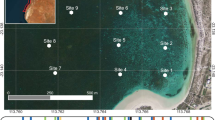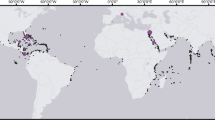Abstract
Increasing atmospheric CO2 equilibrates with surface seawater, elevating the concentration of aqueous hydrogen ions. This process, ocean acidification, is a future and contemporary concern for aquatic organisms, causing failures in Pacific oyster (Crassostrea gigas) aquaculture. This experiment determines the effect of elevated pCO2 on the early development of C. gigas larvae from a wild Pacific Northwest population. Adults were collected from Friday Harbor, Washington, USA (48°31.7′N, 12°1.1′W) and spawned in July 2011. Larvae were exposed to Ambient (400 μatm CO2), MidCO2 (700 μatm), or HighCO2 (1,000 μatm). After 24 h, a greater proportion of larvae in the HighCO2 treatment were calcified as compared to Ambient. This unexpected observation is attributed to increased metabolic rate coupled with sufficient energy resources. Oyster larvae raised at HighCO2 showed evidence of a developmental delay by 3 days post-fertilization, which resulted in smaller larvae that were less calcified.






Similar content being viewed by others
References
Banks SC, Ling SD, Johnson CR, Piggott MP, Williamson JE, Behergegaray LB (2010) Genetic structure of a recent climate change-driven range extension. Mol Ecol 19:2011–2024
Barton A, Hales B, Waldbusser G, Langdon C, Feely RA (2012) The Pacific oyster, Crassostrea gigas, shows negative correlation to naturally elevated carbon dioxide levels: implications for near-term ocean acidification impacts. Limnol Oceanogr 57:698–710
Beniash E, Ivanina A, Lieb NS, Kurochkin Il, Sokolova IM (2010) Elevated levels of carbon dioxide affects metabolism and shell formation in oysters Crassostrea virginica. Mar Ecol Prog Ser 419:95–108
Bonar DB, Coon SL, Walch M, Weiner RM, Fitt W (1990) Control of oyster settlement and metamorphosis by endogenous and exogenous chemical cues. Bull Mar Sci 46:484–498
Byrne M, Ho M, Wong E, Soars NA, Selyakumaraswamy P, Shepard-Brennand H, Dworjanyn SA, David AR (2010a) Unshelled abalone and corrupted urchins: development of marine calcifiers in a changing ocean. Proc R Soc B. doi:10.1098/rspb.2010.2404
Byrne RH, Mecking S, Feely RA, Liu X (2010b) Direct observations of basin-wide acidification of the North Pacific Ocean. Geophys Res Lett. doi:10.1029/2009GL040999
Caldeira K, Wickett ME (2003) Anthropogenic carbon and ocean pH. Nature 425:365
Catarino AI, De Ridder C, Gonzalez M, Gallardo P, Dubois P (2011) Sea urchin Arbacia dufresnei (Blainville 1825) larvae response to ocean acidification. Polar Biol. doi:10.1007/s00300-011-1074-2
Coen LD, Luckenbach MW (2000) Developing success criteria and goals for evaluating oyster reef restoration: ecological function or resource exploitation? Ecol Eng 15:323–343
Crim RN, Sunday JM, Harley CDG (2011) Elevated seawater CO2 concentrations impair larval development and reduce larval survival in endangered northern abalone (Haliotis kamtschatkana). J Exp Mar Biol Ecol 400:272–277
Dickson AG (1990) Thermodynamics of the dissociation of boric acid in synthetic seawater from 273.15 to 318.15 K. Deep Sea Res Part A, Oceanogr Res Pap 37(5):755–766
Dickson AG, Sabine CL, Christian JR (2007) Guide to best practices for ocean CO2 measurements. North Pacific Marine Science Organization, Sidney, British Columbia, p 176
Dupont S, Lundve B, Thorndyke M (2010) Near future ocean acidification increases growth rate of the lecithotrophic larvae and juveniles of the sea star Crossaster papposus. J Exp Zool (Mol Dev Evol) 314B:382–389
Elston RA, Hasegawa H, Humphrey KL, Polyak IK, Häse CC (2008) Re-emergence of Vibrio tubiashii in bivalve aquaculture: severity, environmental drivers, geographic extent, and management. Dis Aquat Org 82:119–134
Fassbender AJ, Sabine CL, Feely RA, Langdon C, Mordy CW (2011) Inorganic carbon dynamics during northern California coastal upwelling. Cont Shelf Res 31:1180–1192
Feely RA, Sabine CL, Hernandez-Ayon JM, Ianson D, Hales B (2008) Evidence for upwelling of corrosive “acidified” water onto the continental shelf. Science 320:1490–1492
Feely RA, Alin SR, Newton J, Sabine CL, Warner M, Devol A, Krembs C, Maloy C (2010) The combined effects of ocean acidification, mixing, and respiration on pH and carbonate saturation in an urbanized estuary. Estuar Coast Shelf Sci 88:442–449
FAO Fisheries and Aquaculture Department (2010) World aquaculture 2010. FAO Fisheries and Aquaculture Department. Technical Paper. No. 500/1. Rome, FAO. 2011. 105 pp
Gallager SM, Mann R, Sasaki GC (1986) Lipid as an index of growth and viability in three species of bivalve larvae. Aquaculture 56:81–103
Gaylord B, Hill TM, Sanford E, Lenz EA, Jacobs LA, Sato KN, Russell AN, Hettinger A (2011) Functional impacts of ocean acidification in an ecologically critical foundation species. J Exp boil 214:2586–2594
Gazeau F, Gattuso J-P, Greaves M, Elderfield H, Peene J, Heip CHR, Middelburg JJ (2011) Effects of carbonate chemistry alteration on early embryonic development of the Pacific oyster (Crassostrea gigas). PLoS ONE. doi:10.1371/journal.pone.0023010
Hauri C, Gruber N, Plattner G-K, Alin S, Feely RA, Hales B, Wheeler PA (2009) Ocean acidification in the California current system. Oceanography 22:60–71
Henry RP, Kormanik GA, Smatresk NJ, Cameron JN (1981) The role of CaCO3 dissolution as a source of HCO3 − for the buffering of hypercapnic acidosis in aquatic and terrestrial decapod crustaceans. J Exp Biol 94:269–273
IPCC (2007) Climate change 2007: synthesis report. In: Core Writing Team, Pachauri RK, Reisinger A (eds) Contribution of working groups I, II and III to the fourth assessment report of the intergovernmental panel on climate change. IPCC, Geneva
Kurihara H, Kato S, Ishimatsu A (2007) Effects of increased seawater pCO2 on early development of the oysters Crassostrea gigas. Aquatic Biology 1:91–98
LaBarbera M (1974) Calcification of the first larval shell of Tridacna squamosa (Tridacnidae: Bivalvia). Mar Biol 25:233–238
Lannig G, Eilers S, Pörtner HO, Sokolova IM, Bock C (2010) Impact of ocean acidification on energy metabolism of Oyster, Crassostrea gigas-changes in metabolic pathways and thermal response. Mar Drugs 8:2318–2339
Lueker TJ, Dickson AG, Keeling CD (2000) Ocean pCO2 calculated from dissolved inorganic carbon, alkalinity, and equations for K1 and K2—validation based on laboratory measurements of CO2 in gas and seawater at equilibrium. Mar Chem 70:105–119
Marchant HK, Calosi P, Spicer JI (2010) Short-term exposure to hypercapnia does not compromise feeding, acid-base balance or respiration of Patella vulgata but surprisingly is accompanied by radula damage. J Mar Biol Assoc UK 90:1379–1384
Melzner F, STange P, Trubenbach K, Thomsen J, Casties I, Panknin U, Gorb SN, Gutowska MA (2011) Food supply and seawater pCO2 impact calcification and internal shell dissolution in the blue mussel Mytilus edulis. PLoS ONE 6:e24223. doi:10.1371/journal.pone.0024223
Miles H, Widdicombe S, Spicer JI, Hall-Spencer J (2007) Effects of anthropogenic seawater acidification on acid-base balance in the sea urchin Psammechinus miliaris. Mar Pollut Bull 54:89–96
Miller AW, Reynolds AC, Sobrino C, Riedel GF (2009) Shellfish face uncertain future in high CO2 world: influence of acidification on oyster larvae calcification and growth in estuaries. PLoS ONE 4:e5661. doi:10.1371/journal.pone.0005661
Narita D, Rehdanz K, Tol RSJ (2012) Economic costs of ocean acidification: a look into the impacts on global shellfish production. Clim Change. doi:10.1007/s10584-011-0383-3
O’Donnell MJ, Hammond LM, Hofmann GE (2009) Predicted impact of ocean acidification on a marine invertebrate: elevated CO2 alters response to thermal stress in sea urchin larvae. Mar Biol 156:439–446
Pace DA, Marsh AG, Leong PK, Green AJ, Hedgecock D, Manahan DT (2006) Physiological bases of energetically determined variation in growth of marine invertebrate larvae: a study of growth heterosis in the bivalve Crassostrea gigas. J Exp Mar Biol Ecol 335:188–209
Pane EF, Barry JP (2007) Extracellular acid-base regulation during short-term hypercapnia is effective in a shallow-water crab, but ineffective in a deep-sea crab. Mar Ecol Prog Ser 334:1–9
Parker LM, Ross PM, O’Connor WA (2010) comparing the effect of elevated pCO2 and temperature on the fertilization and early development of two species of oysters. Mar Biol 157:2435–2452
Parker LM, Ross PM, O’Connor WA, Borysko L, Raftos DA, Portner H-O (2012) Adult exposure influences offspring response to ocean acidification in oysters. Glob Change Biol 18:82–92
Perry A, Low PJ, Ellis JR, Reynolds JD (2005) Climate change and distribution shifts in marine fishes. Science 308:1912–1915
Ries JB (2011) A physicochemical framework for interpreting the biological calcification response to CO2-induced ocean acidification. Geochim Cosmochim Acta 75:4053–4064
Robbins LL, Hansen ME, Kleypas JA, Meylan SC (2010) CO2calc: a user-friendly carbon calculator for windows, Mac OS X, and iOS (iPhone): U.S. geological survey open file report 2010–1280, 42 pp
Strathmann RR (1985) Feeding and nonfeeding larval development and life-history evolution in marine invertebrates. Ann Rev Ecol Syst 16:339–361
Stumpp M, Wren J, Melzner F, Thorndyke MC, Dupont ST (2011a) CO2 induced seawater acidification impacts sea urchin larval development I: elevated metabolic rates decrease scope for growth and induce developmental delay comparative biochemistry and physiology—part a: molecular and integrative. Physiology 160:331–340
Stumpp M, Dupont ST, Thorndyke MC, Melzner F (2011b) CO2 induced seawater acidification impacts sea urchin larval development II: gene expression patterns in pluteus larvae. Comparative biochemistry and physiology—part a: molecular and Integrative. Physiology 160:320–330
Talmage SC, Gobler CJ (2011) Effects of elevated temperature and carbon dioxide on the growth and survival of larvae and juveniles of three species of northwest Atlantic bivalves. PLoS One. doi:10.1371/journal.pone.0026941
Thomsen J, Melzner F (2010) Moderate seawater acidification does not elicit long-term metabolic depression in the blue mussel Mytilus edulis. Mar Biol 157:2667–2676
Tomanek L, Zuzow MJ, Ivanina AV, Beniash E, Sokolova IM (2011) Proteomic response to elevated pCO2 level in eastern oysters, Crassostrea virginica: evidence for oxidative stress. J Exp Biol 214:1836–1844
Underwood AJ, Fairweather PG (1989) Supply-side ecology and benthic marine assemblages. Trends Ecol Evol 4:16–20
Wanninkhof R (1992) Relationship between wind speed and gas exchange over the ocean. J Geophys Res 97(5):7373–7382
Watson S-A, Southgate PC, Tyler PA, Peck LS (2009) Early larval development of the Sydney rock oyster Saccostrea glomerata under near-future predictions of CO2-driven ocean acidification. J Shellfish Res 28:431–437
Weiss IM (2011) Biomaterials: metabolites empowering minerals. Nat Chem Biol 7:192–193
Weiss IM, Tuross N, Addadi L, Weiner S (2002) Mollusc larval shell formation: amorphous calcium carbonate is a precursor phase for aragonite. J Exp Zool 293:478–491
Wong KKW, Lane AC, Leung PTY, Thiyagarajan V (2011) Response of larval barnacle proteome to CO2-driven seawater acidification. Comp Biochem Physiol D Genomics Proteomics 6:310–321
Yu PC, Matson PG, Martz TR, Hofmann GE (2011) The ocean acidification seascape and its relationship to the performance of calcifying marine invertebrates: laboratory experiments on the development of urchin larvae framed by environmentally-relevant pCO2/pH. J Exp Mar Biol Ecol 400:288–295
Acknowledgments
We would like to thank Drs. Ken Sebens and Emily Carrington for use of lab space and facilities at Friday Harbor Labs. Support from National Science Foundation grant EF1041213 to Dr. Carrington funded the construction of the ocean acidification system and analytical equipment used in this study. National Oceanographic and Atmospheric Administration Saltonstall-Kennedy Program grant # NA09NMF4270093 to Dr. Steven Roberts and Dr. Carolyn Friedman also supported this research project. Matt George, Laura Newcomb, and Michelle Herko provided help with maintenance of the ocean acidification system, larval care, and water chemistry analysis, respectively. Thank you to Dr. Richard Strathmann for his advice on larval care and to Dr. Billie Swalla for advice on fixation and for use of her lab space. Dr. Brent Vadopalas and Dr. Loveday Conquest were incredibly helpful with advice on statistical analysis. Lisa Crosson, Mackenzie Gavery, Caroline Storer, and Sam White provided valuable, critical feedback during the writing process. We are very appreciative of the thorough and helpful comments from two anonymous reviewers and from the editor of this issue, Dr. Sam Dupont.
Author information
Authors and Affiliations
Corresponding author
Additional information
Communicated by S. Dupont.
Rights and permissions
About this article
Cite this article
Timmins-Schiffman, E., O’Donnell, M.J., Friedman, C.S. et al. Elevated pCO2 causes developmental delay in early larval Pacific oysters, Crassostrea gigas . Mar Biol 160, 1973–1982 (2013). https://doi.org/10.1007/s00227-012-2055-x
Received:
Accepted:
Published:
Issue Date:
DOI: https://doi.org/10.1007/s00227-012-2055-x




